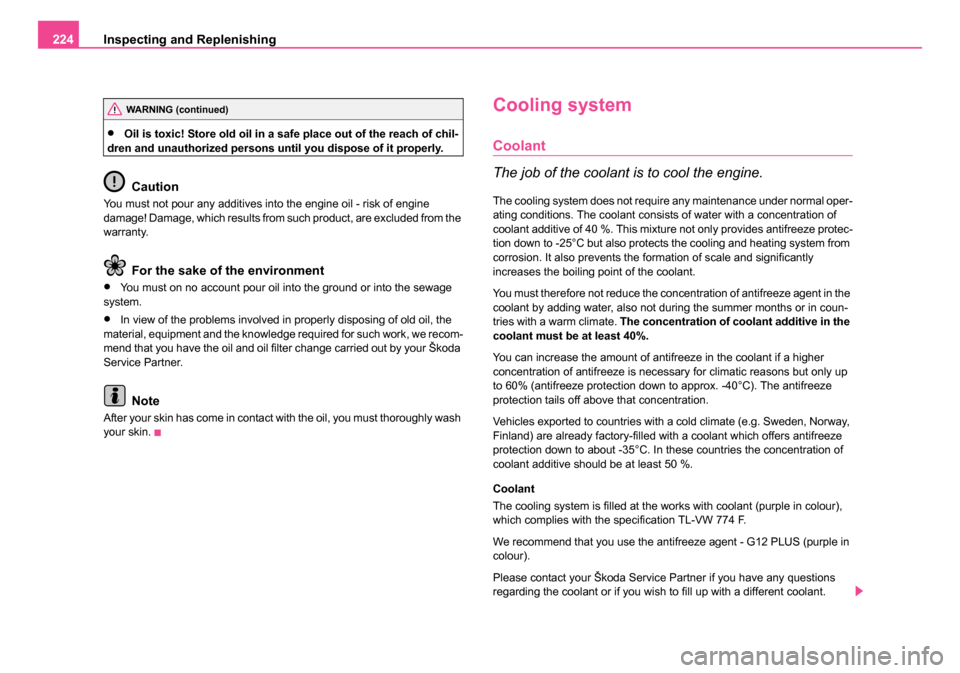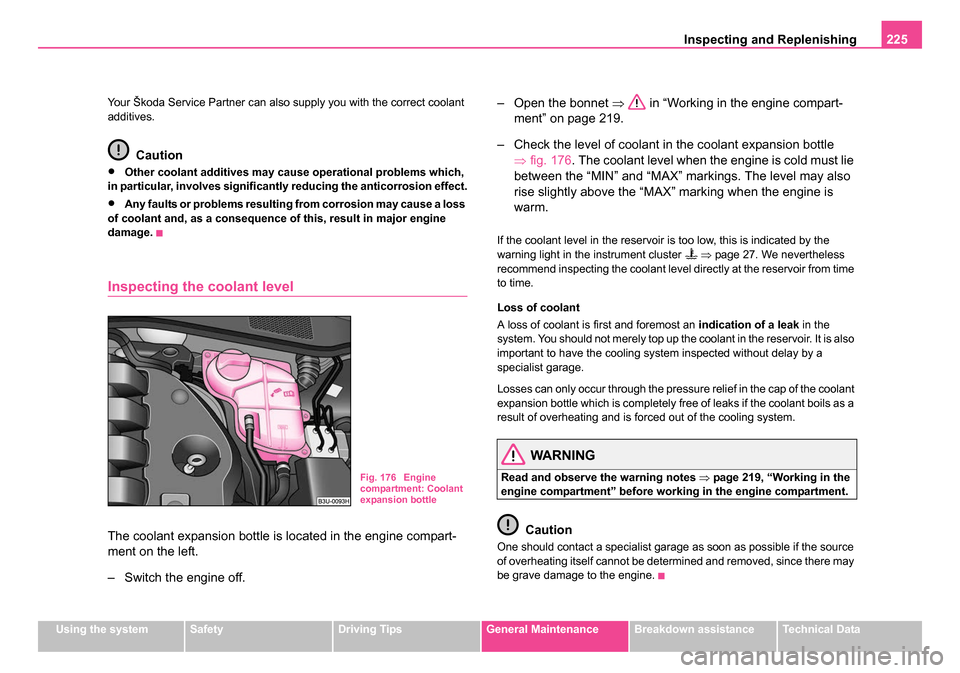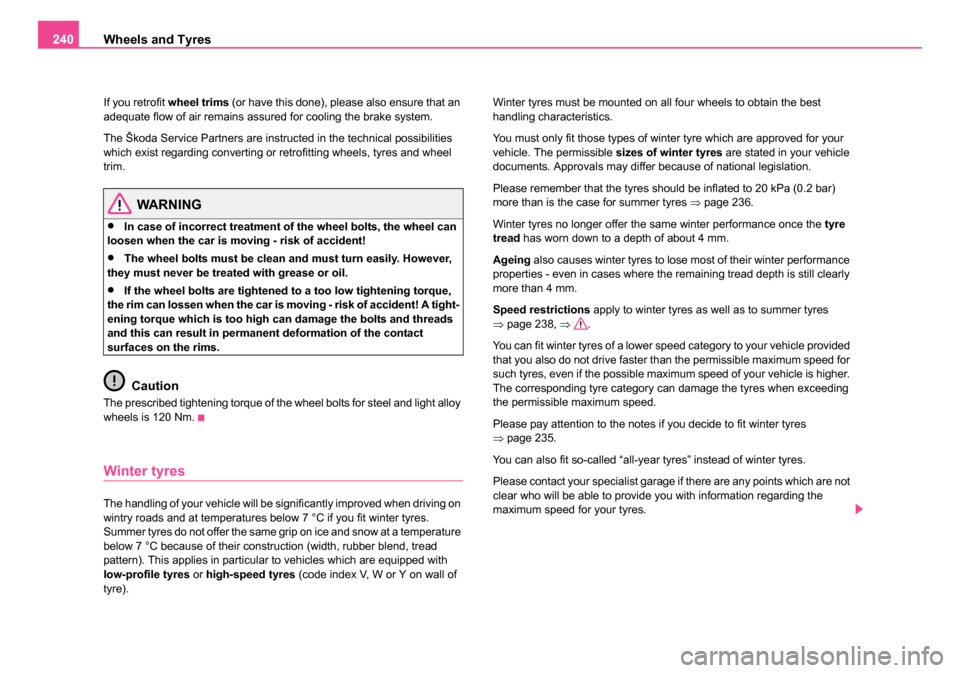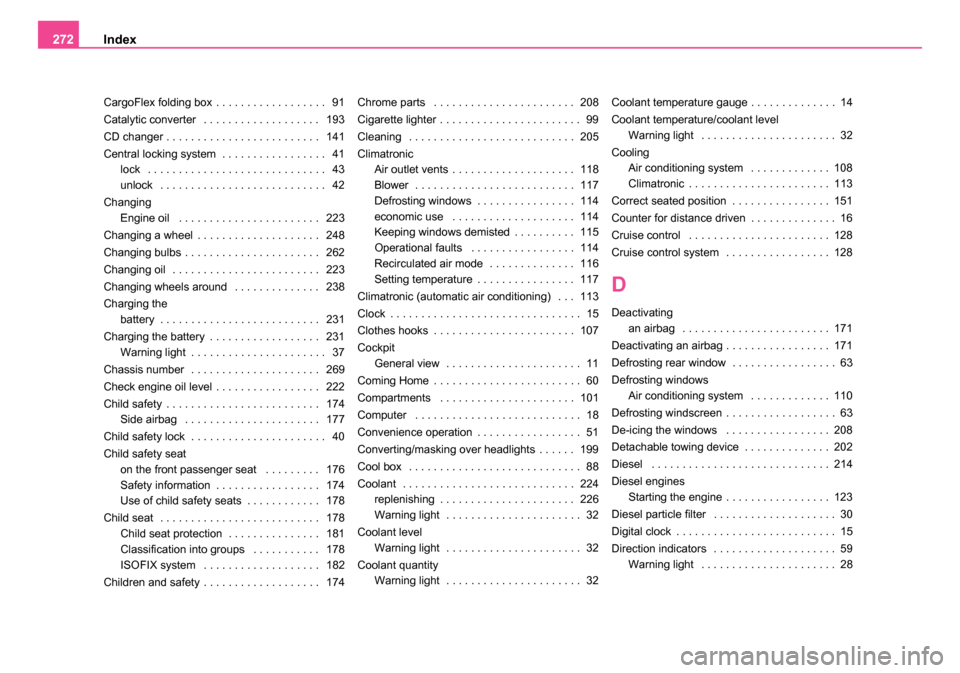cooling SKODA SUPERB 2006 1.G / (B5/3U) Owner's Guide
[x] Cancel search | Manufacturer: SKODA, Model Year: 2006, Model line: SUPERB, Model: SKODA SUPERB 2006 1.G / (B5/3U)Pages: 281, PDF Size: 12.67 MB
Page 225 of 281

Inspecting and Replenishing
224
•Oil is toxic! Store old oil in a safe place out of the reach of chil-
dren and unauthorized persons until you dispose of it properly.
Caution
You must not pour any additives into the engine oil - risk of engine
damage! Damage, which results from such product, are excluded from the
warranty.
For the sake of the environment
•You must on no account pour oil into the ground or into the sewage
system.
•In view of the problems involved in properly disposing of old oil, the
material, equipment and the knowledge required for such work, we recom-
mend that you have the oil and oil filter change carried out by your Škoda
Service Partner.
Note
After your skin has come in contact with the oil, you must thoroughly wash
your skin.
Cooling system
Coolant
The job of the coolant is to cool the engine.
The cooling system does not require any maintenance under normal oper-
ating conditions. The coolant consists of water with a concentration of
coolant additive of 40 %. This mixture not only provides antifreeze protec-
tion down to -25°C but also protects the cooling and heating system from
corrosion. It also prevents the formation of scale and significantly
increases the boiling point of the coolant.
You must therefore not reduce the concentration of antifreeze agent in the
coolant by adding water, also not during the summer months or in coun-
tries with a warm climate. The concentration of coolant additive in the
coolant must be at least 40%.
You can increase the amount of antifreeze in the coolant if a higher
concentration of antifreeze is necessary for climatic reasons but only up
to 60% (antifreeze protection down to approx. -40°C). The antifreeze
protection tails off above that concentration.
Vehicles exported to countries with a cold climate (e.g. Sweden, Norway,
Finland) are already factory-filled with a coolant which offers antifreeze
protection down to about -35°C. In these countries the concentration of
coolant additive should be at least 50 %.
Coolant
The cooling system is filled at the works with coolant (purple in colour),
which complies with the specification TL-VW 774 F.
We recommend that you use the antifreeze agent - G12 PLUS (purple in
colour).
Please contact your Škoda Service Partner if you have any questions
regarding the coolant or if you wish to fill up with a different coolant.
WARNING (continued)
NKO B5 20.book Page 224 Monday, July 3, 2006 2:09 PM
Page 226 of 281

Inspecting and Replenishing225
Using the systemSafetyDriving TipsGeneral MaintenanceBreakdown assistanceTechnical Data
Your Škoda Service Partner can also supply you with the correct coolant
additives.
Caution
•Other coolant additives may cause operational problems which,
in particular, involves significantly reducing the anticorrosion effect.
•Any faults or problems resulting from corrosion may cause a loss
of coolant and, as a consequence of this, result in major engine
damage.
Inspecting the coolant level
The coolant expansion bottle is located in the engine compart-
ment on the left.
– Switch the engine off. – Open the bonnet
⇒ in “Working in the engine compart-
ment” on page 219.
– Check the level of coolant in the coolant expansion bottle ⇒fig. 176. The coolant level when the engine is cold must lie
between the “MIN” and “MAX” markings. The level may also
rise slightly above the “MAX” marking when the engine is
warm.
If the coolant level in the reservoir is too low, this is indicated by the
warning light in the instrument cluster ⇒ page 27. We nevertheless
recommend inspecting the coolant level directly at the reservoir from time
to time.
Loss of coolant
A loss of coolant is first and foremost an indication of a leak in the
system. You should not merely top up the coolant in the reservoir. It is also
important to have the cooling system inspected without delay by a
specialist garage.
Losses can only occur through the pressure relief in the cap of the coolant
expansion bottle which is completely free of leaks if the coolant boils as a
result of overheating and is forced out of the cooling system.
WARNING
Read and observe the warning notes ⇒page 219, “Working in the
engine compartment” before working in the engine compartment.
Caution
One should contact a specialist garage as soon as possible if the source
of overheating itself cannot be determined and removed, since there may
be grave damage to the engine.
Fig. 176 Engine
compartment: Coolant
expansion bottle
NKO B5 20.book Page 225 Monday, July 3, 2006 2:09 PM
Page 227 of 281

Inspecting and Replenishing
226
Replenishing the coolant
– Switch the engine off.
– Allow the engine to cool down.
– Place a cloth over the cap of the coolant expansion reservoir
⇒page 225, fig. 176 and unscrew the cap carefully by
turning it to the left ⇒.
– Top up the coolant.
– Screw the cap tight until it is heard to lock.
The coolant which you use for replenishing the system, must comply with
one specific specification ⇒page 224, “Coolant”. Do not use an alterna-
tive additive if the coolant additive G12 PLUS is not available in excep-
tional cases. Just top up the system with water and as soon as possible
arrange adjustment to correct the mixing ratio of water and coolant addi-
tive again by a specialist garage.
Only use fresh coolant for topping up the system.
Do not fill up over the “MAX” marking! Excess coolant which is heated up
is forced out of the cooling system through the pressure relief valve in the
cap of the coolant compensation bottle.
Wait until the engine has cooled down for a system which has suffered a
major loss of coolant before pouring in coolant. This is necessary to avoid
engine damage.
WARNING
•The cooling system is pressurized! Do not open the cap of the
coolant expansion bottle if the engine is still hot - risk of scalding!
•The coolant additive and thus all of the coolant is harmful to
your health. Avoid contact with the coolant. Coolant vapours are
also harmful to the health. It is important, therefore, to always
safely store any coolant additive in its original container out of the
reach of children - risk of poisoning!
•If any splashes of coolant get into your eyes, rinse out your eyes
immediately with clear water and contact a doctor as soon as
possible.
•You should also consult a doctor without delay if you have inad-
vertently swallowed coolant.
Caution
Do not continue your journey if for some reason it is not possible
under the conditions prevailing to top up with coolant. Switch the
engine off and obtain professional assistance from a specialist garage,
otherwise it could lead to severe engine damage.
For the sake of the environment
Do not re-use coolant if it is necessary to drain the coolant in the system.
It should be collected and disposed of in compliance with environmental
protection regulations.
Radiator fan
The radiator fan may switch on suddenly.
The radiator fan is driven by an electric motor and controlled by a thermo-
stat according to the coolant temperature.
WARNING (continued)
NKO B5 20.book Page 226 Monday, July 3, 2006 2:09 PM
Page 241 of 281

Wheels and Tyres
240
If you retrofit wheel trims (or have this done), please also ensure that an
adequate flow of air remains assured for cooling the brake system.
The Škoda Service Partners are instructed in the technical possibilities
which exist regarding converting or retrofitting wheels, tyres and wheel
trim.
WARNING
•In case of incorrect treatment of the wheel bolts, the wheel can
loosen when the car is moving - risk of accident!
•The wheel bolts must be clean and must turn easily. However,
they must never be treated with grease or oil.
•If the wheel bolts are tightened to a too low tightening torque,
the rim can lossen when the car is moving - risk of accident! A tight-
ening torque which is too high can damage the bolts and threads
and this can result in perman ent deformation of the contact
surfaces on the rims.
Caution
The prescribed tightening torque of the wheel bolts for steel and light alloy
wheels is 120 Nm.
Winter tyres
The handling of your vehicle will be significantly improved when driving on
wintry roads and at temperatures below 7 °C if you fit winter tyres.
Summer tyres do not offer the same grip on ice and snow at a temperature
below 7 °C because of their construction (width, rubber blend, tread
pattern). This applies in particular to vehicles which are equipped with
low-profile tyres or high-speed tyres (code index V, W or Y on wall of
tyre). Winter tyres must be mounted on all four wheels to obtain the best
handling characteristics.
You must only fit those types of winter tyre which are approved for your
vehicle. The permissible
sizes of winter tyres are stated in your vehicle
documents. Approvals may differ because of national legislation.
Please remember that the tyres should be inflated to 20 kPa (0.2 bar)
more than is the case for summer tyres ⇒page 236.
Winter tyres no longer offer the same winter performance once the tyre
tread has worn down to a depth of about 4 mm.
Ageing also causes winter tyres to lose most of their winter performance
properties - even in cases where the remaining tread depth is still clearly
more than 4 mm.
Speed restrictions apply to winter tyres as well as to summer tyres
⇒ page 238, ⇒ .
You can fit winter tyres of a lower speed category to your vehicle provided
that you also do not drive faster than the permissible maximum speed for
such tyres, even if the possible maximum speed of your vehicle is higher.
The corresponding tyre category can damage the tyres when exceeding
the permissible maximum speed.
Please pay attention to the notes if you decide to fit winter tyres
⇒ page 235.
You can also fit so-called “all-year tyres” instead of winter tyres.
Please contact your specialist garage if there are any points which are not
clear who will be able to provide you with information regarding the
maximum speed fo r your tyres.
NKO B5 20.book Page 240 Monday, July 3, 2006 2:09 PM
Page 273 of 281

Index
272
CargoFlex folding box . . . . . . . . . . . . . . . . . . 91
Catalytic converter . . . . . . . . . . . . . . . . . . . 193
CD changer . . . . . . . . . . . . . . . . . . . . . . . . . 141
Central locking system . . . . . . . . . . . . . . . . . 41
lock . . . . . . . . . . . . . . . . . . . . . . . . . . . . . 43
unlock . . . . . . . . . . . . . . . . . . . . . . . . . . . 42
Changing Engine oil . . . . . . . . . . . . . . . . . . . . . . . 223
Changing a wheel . . . . . . . . . . . . . . . . . . . . 248
Changing bulbs . . . . . . . . . . . . . . . . . . . . . . 262
Changing oil . . . . . . . . . . . . . . . . . . . . . . . . 223
Changing wheels around . . . . . . . . . . . . . . 238
Charging the battery . . . . . . . . . . . . . . . . . . . . . . . . . . 231
Charging the battery . . . . . . . . . . . . . . . . . . 231 Warning light . . . . . . . . . . . . . . . . . . . . . . 37
Chassis number . . . . . . . . . . . . . . . . . . . . . 269
Check engine oil level . . . . . . . . . . . . . . . . . 222
Child safety . . . . . . . . . . . . . . . . . . . . . . . . . 174 Side airbag . . . . . . . . . . . . . . . . . . . . . . 177
Child safety lock . . . . . . . . . . . . . . . . . . . . . . 40
Child safety seat on the front passenger seat . . . . . . . . . 176
Safety information . . . . . . . . . . . . . . . . . 174
Use of child safety seats . . . . . . . . . . . . 178
Child seat . . . . . . . . . . . . . . . . . . . . . . . . . . 178 Child seat protection . . . . . . . . . . . . . . . 181
Classification into groups . . . . . . . . . . . 178
ISOFIX system . . . . . . . . . . . . . . . . . . . 182
Children and safety . . . . . . . . . . . . . . . . . . . 174 Chrome parts . . . . . . . . . . . . . . . . . . . . . . . 208
Cigarette lighter . . . . . . . . . . . . . . . . . . . . . . . 99
Cleaning . . . . . . . . . . . . . . . . . . . . . . . . . . . 205
Climatronic
Air outlet vents . . . . . . . . . . . . . . . . . . . . 118
Blower . . . . . . . . . . . . . . . . . . . . . . . . . . 117
Defrosting windows . . . . . . . . . . . . . . . . 114
economic use . . . . . . . . . . . . . . . . . . . . 114
Keeping windows demisted . . . . . . . . . . 115
Operational faults . . . . . . . . . . . . . . . . . 114
Recirculated air mode . . . . . . . . . . . . . . 116
Setting temperature . . . . . . . . . . . . . . . . 117
Climatronic (automatic air conditioning) . . . 113
Clock . . . . . . . . . . . . . . . . . . . . . . . . . . . . . . . 15
Clothes hooks . . . . . . . . . . . . . . . . . . . . . . . 107
Cockpit General view . . . . . . . . . . . . . . . . . . . . . . 11
Coming Home . . . . . . . . . . . . . . . . . . . . . . . . 60
Compartments . . . . . . . . . . . . . . . . . . . . . . 101
Computer . . . . . . . . . . . . . . . . . . . . . . . . . . . 18
Convenience operation . . . . . . . . . . . . . . . . . 51
Converting/masking over headlights . . . . . . 199
Cool box . . . . . . . . . . . . . . . . . . . . . . . . . . . . 88
Coolant . . . . . . . . . . . . . . . . . . . . . . . . . . . . 224 replenishing . . . . . . . . . . . . . . . . . . . . . . 226
Warning light . . . . . . . . . . . . . . . . . . . . . . 32
Coolant level Warning light . . . . . . . . . . . . . . . . . . . . . . 32
Coolant quantity Warning light . . . . . . . . . . . . . . . . . . . . . . 32 Coolant temperature gauge . . . . . . . . . . . . . . 14
Coolant temperature/coolant level
Warning light . . . . . . . . . . . . . . . . . . . . . . 32
Cooling Air conditioning system . . . . . . . . . . . . . 108
Climatronic . . . . . . . . . . . . . . . . . . . . . . . 113
Correct seated position . . . . . . . . . . . . . . . . 151
Counter for distance driven . . . . . . . . . . . . . . 16
Cruise control . . . . . . . . . . . . . . . . . . . . . . . 128
Cruise control system . . . . . . . . . . . . . . . . . 128
D
Deactivating an airbag . . . . . . . . . . . . . . . . . . . . . . . . 171
Deactivating an airbag . . . . . . . . . . . . . . . . . 171
Defrosting rear window . . . . . . . . . . . . . . . . . 63
Defrosting windows Air conditioning system . . . . . . . . . . . . . 110
Defrosting windscreen . . . . . . . . . . . . . . . . . . 63
De-icing the windows . . . . . . . . . . . . . . . . . 208
Detachable towing device . . . . . . . . . . . . . . 202
Diesel . . . . . . . . . . . . . . . . . . . . . . . . . . . . . 214
Diesel engines Starting the engine . . . . . . . . . . . . . . . . . 123
Diesel particle filter . . . . . . . . . . . . . . . . . . . . 30
Digital clock . . . . . . . . . . . . . . . . . . . . . . . . . . 15
Direction indicators . . . . . . . . . . . . . . . . . . . . 59 Warning light . . . . . . . . . . . . . . . . . . . . . . 28
NKO B5 20.book Page 272 Monday, July 3, 2006 2:09 PM